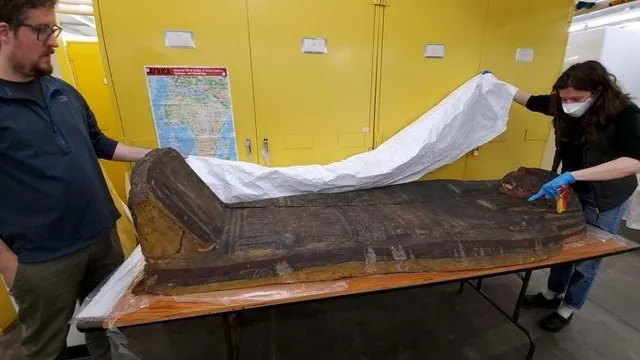
Researchers replicate ancient Egyptian blue pigment lost for 5000 years
2025-06-16 00:00- Researchers from Washington State University successfully recreated ancient Egyptian blue pigment, which was used for centuries.
- They collaborated with notable institutions like the Carnegie Museum of Natural History and Smithsonian’s Museum Conservation Institute.
- The recreated pigments, now part of a museum collection, have sparked interest for potential technological applications.
Express your sentiment!
Insights
In a remarkable scientific achievement, researchers from Washington State University successfully recreated an ancient blue pigment known as Egyptian blue, which had been lost to time for 5000 years. This pigment was predominantly used in ancient Egypt and later by the Romans, marking its significance in historical artistry. Collaborating with both the Carnegie Museum of Natural History and the Smithsonian's Museum Conservation Institute, the team conducted an extensive analysis of the original pigment found in various museum artefacts. Their goal was to identify and replicate the methods used in ancient times, to produce a modern version of this vibrant dye. Through their efforts, the researchers developed several recipes involving key components such as silicon dioxide, copper, calcium, and sodium carbonate. They meticulously controlled the heating process, limiting the temperature to around 1000 degrees Celsius (approximately 1800 degrees Fahrenheit), since ancient methods would not have accessed modern industrial heating capabilities. Analysis showed that variations in the recipes resulted in subtle differences in pigment composition without greatly affecting the color's intensity, allowing the blue dye to stand out even when mixed with other materials. The recreated Egyptian blue pigments are currently part of the collection at the Carnegie Museum of Natural History in Pittsburgh, Pennsylvania, signifying their cultural importance. Their research findings, published in a research paper, reveal the nuanced process involved in both the ancient and modern replication of Egyptian blue, underscoring the complexity of historical pigments that often feature unique, region-based variations. The researchers highlighted their excitement in reconnecting with an art form that was not based on natural pigments, but rather a synthetic creation. Additionally, this recreation has captured the attention of those interested in applying Egyptian blue for new technological purposes. The pigment is noted for producing near-infrared light, which has potential applications in areas such as fingerprint analysis and secure ink for anti-counterfeiting measures. As enthusiasm grows for exploring the advantages and applications of Egyptian blue, it symbolizes both a historical and contemporary intersection of art and technology.
Contexts
Egyptian blue pigment, known as one of the earliest synthetic pigments, holds significant historical and artistic value, dating back to the early dynastic period of ancient Egypt around 2600 BCE. This vibrant blue hue was produced through a specialized process involving the heating of silica, lime, copper, and alkali, which produced a crystalline compound known as calcium copper silicate. The pigment's unique chemical composition gave it a distinct, bright blue color that was highly prized for use in various forms of art, decoration, and ceremonial applications, including funerary art and statuary, where it symbolized life and the divine. The formulation of Egyptian blue represents one of the first instances of human ingenuity in creating synthetic materials, setting a precedent for future developments in pigment technology. The production process of Egyptian blue was quite advanced for its time, involving careful control of temperature and materials. It was typically produced by heating the raw ingredients together at temperatures between 900°C and 1000°C, resulting in a solid glassy phase that, upon cooling, formed small blue particles. These particles could then be ground into a fine powder to be used in paints and cosmetics. The pigment was applied to various substrates, including papyrus, wood, and plaster, providing a striking contrast in the artworks it adorned. Its durability and resistance to fading under sunlight and atmospheric conditions contributed to the preservation of the color in many ancient artifacts, enabling modern scholars to study its applications and significance. Egyptian blue not only served an aesthetic purpose but also had a cultural and symbolic resonance in ancient Egypt, often associated with the sky and the heavens. It was linked to deities, especially those representing the afterlife, such as Osiris and Horus, as a means of connecting the earthly realm with the divine. Additionally, this pigment was utilized in the mummification process, where it was used to adorn tombs and coffins, serving both decorative and protective functions. The pigment also appears in artifacts from other ancient civilizations, indicating its extensive trade, dissemination, and impact beyond Egypt, influencing practices in places such as Greece and Rome. In contemporary art and restoration practices, Egyptian blue remains a subject of interest due to its unique properties and historical significance. Modern scientists and artists continue to explore the techniques behind its creation and application. Researchers have endeavored to recreate the pigment to understand its historical usage better and to enhance preservation practices for ancient artifacts. Furthermore, the discovery of materials with similar properties, such as synthetic blues in modern chemistry, illustrates the lasting impact of ancient Egyptian innovations on contemporary material science. Thus, Egyptian blue not only captures the imagination of historians and artists alike but also represents a pivotal advancement in the history of color production, reflecting a sophisticated understanding of materials that resonates through the ages.